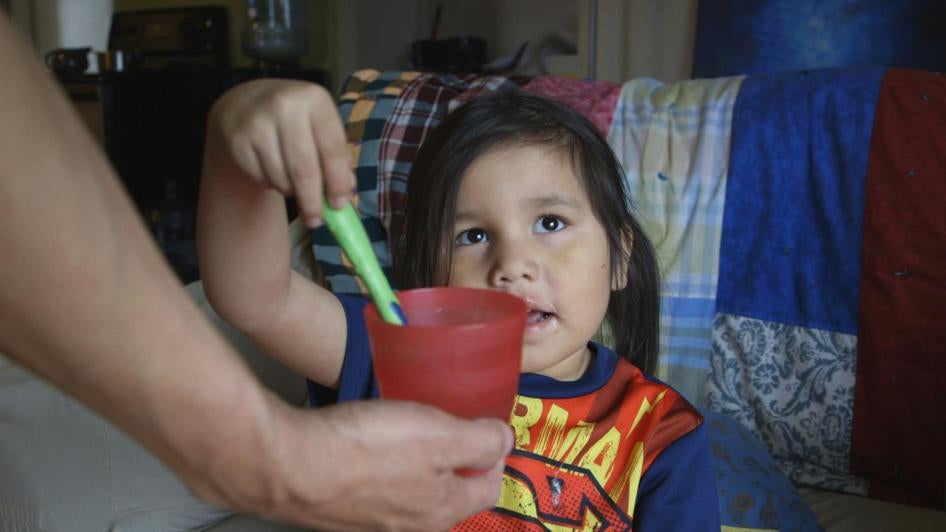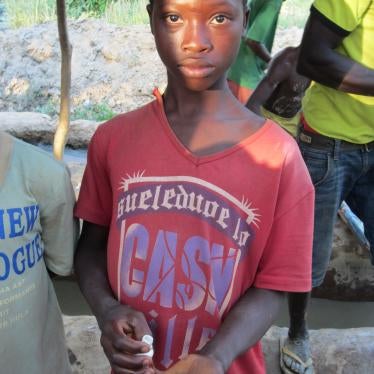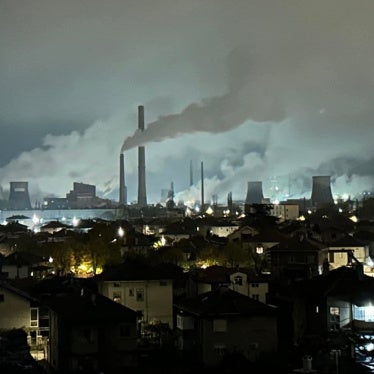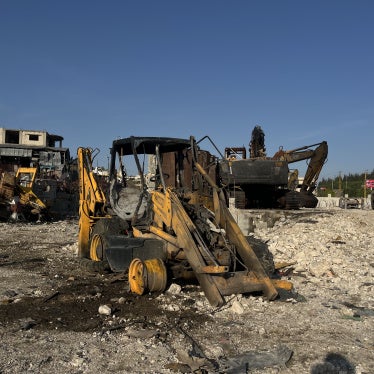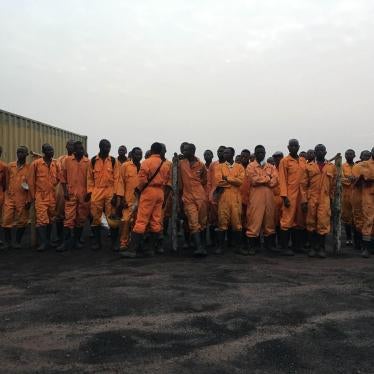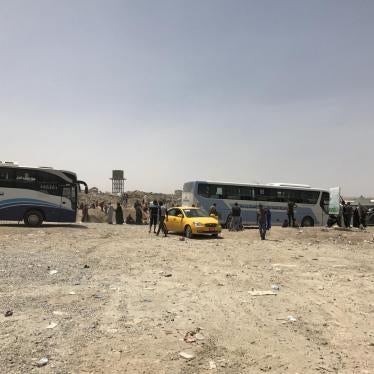Human Rights Watch appreciates the opportunity to provide a submission to the Committee on the Rights of the Child on child rights and the environment, prior to its Day of General Discussion on the topic.
Millions of children around the world suffer violations of their rights to health, food, water, and other rights because of problematic government responses or inaction to environmental degradation and climate change. Children from marginalized groups—such as children from indigenous communities—are often particularly affected.
National environmental laws and policies infrequently address the rights of children. And international environmental agreements have long ignored a human rights approach, including the rights of children. This gap hinders rights-based approaches to environmental problems affecting children.
Including rights, if not specifically children’s rights, in environmental instruments has started to happen. The Paris Agreement on climate change and the Sustainable Development Goals (SDGs), both adopted last year, take a more integrated approach to human rights and environmental issues.
Human Rights Watch considers the upcoming Day of General Discussion an important opportunity to inform the next steps to protect children from rights impacts linked to environmental damage. Human Rights Watch recommends that the Committee on the Rights of the Child use the Day of General Discussion as a starting point for developing a General Comment on Child Rights and the Environment designed to clarify state obligations and business responsibilities, convey the relevance of the Convention on the Rights of the Child (CRC) to environmental policies, and help strengthen linkages between child rights and the environment.
Impact of environmental harm on children’s rights
According to the World Health Organization (WHO), 1.7 million children under the age of 5 died in 2012 because they lived in an unhealthy environment.[1] Human Rights Watch has documented for over a decade how governments have failed to protect children from environmental damage. Below are some selected examples.
Exposure to toxic substances
Human Rights Watch has documented children’s exposure to hazardous substances in many contexts on video and in detailed reports.[2] Around the world, children are exposed to hazardous substances while playing on the ground, bathing in rivers, going to school, eating or drinking, or working.[3] Many hazardous substances have particularly harmful consequences for children, whose developing bodies absorb them more readily than those of adults and are especially vulnerable to certain toxins, leading in some cases to irreversible long-term damage, disability, or even death.
Children’s exposure as result of business activity
Business activity has been the source of significant environmental damage that harms children through air pollution, poor quality drinking water, and other routes of exposure. Governments often fail to regulate companies sufficiently. For example, children living near or working in leather tanneries in Bangladesh have been exposed to chemicals that flowed off tannery floors into open gutters of nearby streets. They have shown severe health problems, including fevers, diarrhoea, respiratory problems, and skin, stomach, and eye conditions.[4] Smelters or battery factories have caused lead poisoning in children in China and Kenya, and protests by parents have been met with government repression.[5] In agriculture, child laborers have been exposed to fertilizers and pesticides in Indonesia, the United States, and Israel/Palestine.[6] Children working in tobacco farming have also suffered from symptoms that are consistent with nicotine poisoning.[7]
Children’s health has also been severely affected by exposure to chemicals from large-scale and small-scale mining operations. In one of the worst environmental health disasters in recent years, over 400 children died in Nigeria from exposure to lead-contaminated dust produced inadvertently during artisanal and small-scale gold mining.[8] Children from ethnic minority groups living in camps for the internally displaced in Kosovo have suffered lead poisoning due to contamination from a nearby industrial mine.[9] In small-scale gold mining regions in Mali, Ghana, Tanzania, the Philippines, and elsewhere, children have been exposed to toxic mercury used to process gold, and in some cases developed symptoms that are consistent with mercury poisoning.[10]
Hazardous substances in water supply systems
Governments have sometimes failed to protect children from hazardous chemicals in the ground, groundwater, or water supply system. In Bangladesh, for example, millions of children have been exposed to arsenic contamination via well water, considered an improved source.[11] In Canada, indigenous communities have been exposed to water containing naturally occurring uranium, E.coli, or the presence of coliform.[12] In Harare, Zimbabwe, Human Rights Watch found that raw sewage occasionally ran from the city‘s taps, exposing children to dangerous waterborne diarrheal diseases.[13]
Climate change
Climate change impacts children’s access to water, food, and healthcare. Governments need to address the human rights consequences of climate change on children. Children from indigenous communities are often particularly vulnerable because their culture and livelihood is tied to their land, and such marginalized groups typically lack the resources and government support to respond to climate change’s effects.
In the Turkana region of Kenya, Human Rights Watch found that climate change, along with other environmental, political, and economic development challenges, has limited local indigenous communities’ access to food and clean water. As a result, many children have become sick because their families are unable to provide them with sufficient food and clean water. Girls often walk extremely long distances to dig for water in dry riverbeds, exposing them to dangers along the route and leaving them with less time to attend school or rest.[14] Scientific studies show that recurring drought and food insecurity can also have indirect effects on health. For example, climate change has changed the behavior of mosquitoes and ticks that transmit diseases such as malaria.[15]
Climate change has also had other impacts that affect the ability of governments to protect children’s rights. In Bangladesh, families have arranged child marriages for their daughters under 18 because of extreme poverty, compounded by natural disasters and climate change. Given the lack of a government safety net, some families have rushed to marry off these girls in anticipation of losing their homes to river erosion.[16]
State obligations regarding the rights of the child and the environment
Convention on the Rights of the Child and the Environment
The Convention on the Rights of the Child lays out strong child rights protections relating to the environment, and contains two explicit references to the environment: First, the Convention links the child’s right to the highest attainable standard of health, including the right to nutritious food and safe drinking water, to issues of environmental pollution (art. 24). Second, it defines the child’s right to information on environmental health issues and defines environmental education as one of the goals of education (art. 29). But the Convention’s relevance is much broader; it provides a range of additional relevant protections including on child labor, child marriage, and business-related abuses.
Human Rights Watch believes that the Committee should start the process of drafting a General Comment on Child Rights and the Environment, designed to spell out state obligations and business responsibilities, including on children’s access to environmental information, children’s participation, and accountability for child rights abuses related to environmental harm. In addition to clarifying obligations, a General Comment would convey the relevance of the Convention to a wide range of actors working on child rights and the environment, and help strengthen linkages between child rights and the environment.
Government and Inter-Governmental role
Governments often lack the political will or resources to protect children from environmental harm. In addition, the split between environmental law and human rights law has contributed to a lack of coordination between agencies dealing with child protection, child health, and environmental issues within both governments and the United Nations.
The neglect for child rights concerns is reflected in their near-absence in international treaties and many national environmental laws and policies, and poor monitoring and accountability for violations of child rights that relate to the environment. If children are mentioned in environmental laws, they are typically described as a vulnerable group, not as rights holders. Environmental treaties such as the Stockholm Convention on Persistent Pollutants and other chemicals conventions do not reference human rights obligations at all, let alone children’s rights, despite their relevance. There is also evidently a lack of monitoring mechanisms on the national level. This is concerning because health effects may not be manifest for years after exposure, or exposure to carcinogens or climate change occurs slowly. Accountability can also be hampered by the lack of solid data.
United Nations agencies such as the United Nations Environment Programme (UNEP), the United Nations Development Programme (UNDP), and the United Nations Framework Convention on Climate Change (UNFCCC) have not made environment-related child rights central to their agenda, and infrequently coordinate with UN agencies with expertise on child rights. Children’s rights are absent from the policy frameworks and actions that UNEP, UNDP, and UNFCCC use to guide and inform government laws and policies.[17]
Our research has found that at the national level, government ministries for the environment often do not coordinate with ministries responsible for child protection or child health, resulting in an absence of child-specific measures. An example is the absence of screening and health education efforts to prevent children from being exposed to mercury in primary healthcare clinics located in mining areas where children commonly work with mercury.[18] Conversely, international and national government child protection initiatives, for example programs on hazardous child labor or on children’s healthcare, often only superficially touch on environmental concerns.
Governments should ensure that their laws, policies, and actions on the environment explicitly include measures relating to child rights. In turn, laws, policies, and actions on child rights and children’s health should explicitly include protection from environmental harm such as toxic pollution and climate change.
Efforts should also be made to strengthen accountability for past violations and to require companies to conduct supply chain due diligence with regards to the harmful effects of environmental damage on child rights.[19]
Business responsibility
Many companies are responsible for environmental pollution or contribute to child rights abuses, as illustrated above. International norms, such as the UN Guiding Principles on Business and Human Rights, recognize that companies should undertake “human rights due diligence” measures throughout their supply chain. Human rights due diligence includes assessing actual and potential human rights risks; mitigating those risks; ending abuses; and ensuring remedies for any abuses that do occur. Companies should also be fully transparent about these efforts. Human right due diligence includes the rights of children, and should specifically include abuses that flow from environmental harm caused by the companies, in line with the UN Guiding Principles.
Positive steps – some examples
Inclusion of human rights in international environmental law: The 2015 Paris Agreement on climate change is the first international environmental agreement to explicitly recognize the importance of international human rights obligations in the context of climate change.[20]
Measures to prevent and monitor childhood exposure to hazardous substances: The 2013 Minamata Convention on Mercury requires treaty parties to draw up national action plans on artisanal and small-scale gold mining that include strategies to prevent mercury exposure of children and women of child-bearing age.[21] The Convention also calls upon governments to monitor children’s exposure, and provide testing and treatment. On the national level, the Philippines government has trained healthcare workers in artisanal mining areas on mercury-related health conditions.
Government regulation of businesses: Brazil has prohibited all work by children in tobacco, largely because of the risk of exposure to hazardous substances, and established penalties for farmers and companies purchasing the tobacco, creating an incentive for the tobacco industry to ensure that children are not working on farms in their supply chains.[22]
Step towards accountability: Thailand’s supreme administrative court has ordered the government’s Pollution Control Department to pay approximately US$125,000 in compensation to plaintiffs affected by the toxic legacy of a former lead processing factory at Klity Creek, a stream in western Thailand. The court also ordered the government to clean up the toxic site.
Annex: Human Rights Watch Recommendations to the Committee on the Rights of the Child
- Draft a General Comment on Child Rights and the Environment;
- Provide guidance to governments on how to effectively monitor children’s environmental health and address violations of children’s rights;
- Formulate recommendations to governments on how to effectively conduct supply chain due diligence with regard to children’s rights and the environment;
- Reach out to the UNEP, UNFCCC, and WHO to ensure better reflection of child rights in environmental and climate change planning, and seek input on environmental concerns into the Committee on the Rights of the Child’s actions.
[1] World Health Organization, “An estimated 12.6 million deaths each year are attributable to unhealthy environments,” March 15, 2016, http://www.who.int/mediacentre/news/releases/2016/deaths-attributable-to-unhealthy-environments/en/ (accessed April 14, 2016).
[2] We have, for example, produced videos documenting children's exposure to mercury in gold mines in the Philippines, to fertilizers and nicotine in Indonesian tobacco farms, to unsafe drinking water in indigenous communities in Canadam and the effects of climate change on child rights in Turkana, Kenya. Human Rights Watch, Child Marriage in Bangladesh, video, June 9, 2015, https://www.hrw.org/video-photos/video/2015/06/08/child-marriage-bangladesh; Human Rights Watch, Philippines: Children Risk Death For Gold, video, September 30, 2015, https://www.hrw.org/video-photos/video/2015/09/29/philippines-children-risk-death-gold; Human Rights Watch, Hazardous Child Labor on Indonesian Tobacco Farms, video, May 25, 2016, https://www.hrw.org/video-photos/video/2016/05/24/hazardous-child-labor-indonesian-tobacco-farms; Human Rights Watch, Canada's Water Crisis: Indigenous Families at Risk, video, June 09, 2016, https://www.hrw.org/video-photos/video/2016/06/07/canadas-water-crisis-indigenous-families-risk.
[3] The international standard on hazardous child labor is outlined in the International Labour Organization (ILO) Convention No. 182 concerning the Prohibition and Immediate Action for the Elimination of the Worst Forms of Child Labour (Worst Forms of Child Labour Convention), adopted June 17, 1999, 38 I.L.M. 1207 (entered into force November 19, 2000); ILO Recommendation concerning the Prohibition and Immediate Action for the Elimination of the Worst Forms of Child Labour, June 17, 1999, ILO No. R190.
[4] Human Rights Watch, Toxic Tanneries: The Health Repercussions of Bangladesh’s Hazaribagh Leather, October 2012, https://www.hrw.org/reports/2012/10/08/toxic-tanneries.
[5] Human Rights Watch, “My Children Have Been Poisoned:” A Public Health Crisis in Four Chinese Provinces, June 2011, https://www.hrw.org/report/2011/06/15/my-children-have-been-poisoned/public-health-crisis-four-chinese-provinces; Jane Cohen (Human Rights Watch), “Dispatches: Hope for Kenya’s Lead Poisoning Victims,” August 13, 2014, https://www.hrw.org/news/2014/08/13/dispatches-hope-kenyas-lead-poisoning-victims.
[6] Human Rights Watch, Tobacco’s Hidden Children: Hazardous Child Labor in United States Tobacco Farming, May 2014, https://www.hrw.org/report/2014/05/13/tobaccos-hidden-children/hazardous-child-labor-united-states-tobacco-farming; Human Rights Watch, Israel/Palestine-Ripe for Abuse: Palestinian Child Labor in Israeli Agricultural Settlements in the West Bank, April 2015, https://www.hrw.org/report/2015/04/13/ripe-abuse/palestinian-child-labor-israeli-agricultural-settlements-west-bank.
[7] Human Rights Watch, Teens of the Tobacco Fields: Child Labor in United States Tobacco Farming, December 2015, https://www.hrw.org/report/2015/12/09/teens-tobacco-fields/child-labor-united-states-tobacco-farming; Human Rights Watch, “The Harvest is in My Blood”: Hazardous Child Labor in Tobacco Farming in Indonesia, May 2016, https://www.hrw.org/report/2016/05/24/harvest-my-blood/hazardous-child-labor-tobacco-farming-indonesia.
[8] “Nigeria: Child Lead Poisoning Crisis Treat Thousands of Affected Children; Clean Villages; Improve Gold Mining Practices,” Human Rights Watch news release, February 7, 2012, https://www.hrw.org/news/2012/02/07/nigeria-child-lead-poisoning-crisis; Katharina Rall (Human Rights Watch), “Dispatches: Avoiding Lead Poisoning in Nigeria,” May 21, 2015, https://www.hrw.org/news/2015/05/21/dispatches-avoiding-lead-poisoning-nigeria.
[9] Human Rights Watch, Kosovo–Poisoned by Lead: A Health and Human Rights Crisis in Mitrovica’s Roma Camps, June 2009, https://www.hrw.org/report/2009/06/23/kosovo-poisoned-lead/health-and-human-rights-crisis-mitrovicas-roma-camps
[10] Human Rights Watch, A Poisonous Mix: Child Labor, Mercury, and Artisanal Gold Mining in Mali, December 2011, https://www.hrw.org/report/2011/12/06/poisonous-mix/child-labor-mercury-and-artisanal-gold-mining-mali; Human Rights Watch, Toxic Toil: Child Labor and Mercury Exposure in Tanzania’s Small-Scale Gold Mines, August 2013, https://www.hrw.org/report/2013/08/28/toxic-toil/child-labor-and-mercury-exposure-tanzanias-small-scale-gold-mines; Human Rights Watch, Precious Metal, Cheap Labor: Child Labor and Corporate Responsibility in Ghana’s Artisanal Gold Mines, June 2015, https://www.hrw.org/report/2015/06/10/precious-metal-cheap-labor/child-labor-and-corporate-responsibility-ghanas; Human Rights Watch, “What … if Something Went Wrong?” Hazardous Child Labor in Small-Scale Gold Mining in the Philippines, September 2015, https://www.hrw.org/report/2015/09/29/what-if-something-went-wrong/hazardous-child-labor-small-scale-gold-mining.
[11] Human Rights Watch, Nepotism and Neglect: The Failing Response to Arsenic in the Drinking Water of Bangladesh’s Rural Poor, April 2016, https://www.hrw.org/report/2016/04/06/nepotism-and-neglect/failing-response-arsenic-drinking-water-bangladeshs-rural.
[12] Human Rights Watch, Make It Safe: Canada’s Obligation to End the First Nations Water Crisis, June 2016, https://www.hrw.org/report/2016/06/07/make-it-safe/canadas-obligation-end-first-nations-water-crisis.
[13] Human Rights Watch, Troubled Water: Burst Pipes, Contaminated Wells, and Open Defecation in Harare, November 2013, https://www.hrw.org/reports/2013/11/19/troubled-water-0.
[14] Human Rights Watch, “There is No Time Left”: Climate Change, Environmental Threats, and Human Rights in Turkana County, Kenya, October 2015, https://www.hrw.org/report/2015/10/15/there-no-time-left/climate-change-environmental-threats-and-human-rights-turkana.
[15] Intergovernmental Panel on Climate Change, “Climate Change 2007: Synthesis Report. Contribution of Working Groups I, II and III to the Fourth Assessment Report of the Intergovernmental Panel on Climate Change,” 2008, https://www.ipcc.ch/publications_and_data/publications_ipcc_fourth_assessment_report_synthesis_report.htm (accessed July 13, 2016).
[16] Human Rights Watch, Marry Before Your House is Swept Away: Child Marriage in Bangladesh, June 2015, https://www.hrw.org/report/2015/06/09/marry-your-house-swept-away/child-marriage-bangladesh.
[17] See for example policies on chemicals management and adaptation to climate change: UNEP, “Sound Management of Chemicals: UNEP’s contribution to the achievement of the 2020 goal,” http://www.unep.org/chemicalsandwaste/Portals/9/Mainstreaming/Sound%20Management%20of%20Chemicals/SoundManagementofChemicals.pdf; UNFCCC Secretariat, Least Developed Countries Expert Group, National Adaptation Plans. Technical guidelines for the national adaptation plan process, December 2012,
https://unfccc.int/files/adaptation/cancun_adaptation_framework/application/pdf/naptechguidelines_eng_high__res.pdf (accessed August 7, 2015).
[18] Human Rights Watch, A Poisonous Mix; Human Rights Watch, Toxic Toil; Human Rights Watch, Precious Metal, Cheap Labor.
[19] UN Committee on the Rights of the Child, General Comment No. 16, State Obligations regarding the impact of the Business Sector on Children’s Rights, UN doc. CRC/C/GC/16 (2013); Human Rights Watch, Human Rights in Supply Chains: A Call for a Binding Global Standard on Due Diligence, May 2016, https://www.hrw.org/report/2016/05/30/human-rights-supply-chains/call-binding-global-standard-due-diligence.
[20] The preamble states that parties should “respect, promote and consider” human rights – the right to health and the rights of indigenous peoples, as well as “migrants, children, persons with disabilities and people in vulnerable situations” in climate-related actions.
[21] Minamata Convention on Mercury, adopted January 19, 2013, UNEP(DTIE)/Hg/INC.5/7.
[22] Margaret Wurth (Human Rights Watch), “Tobacco’s Children. Brazil Sets An Example for the U.S.,” commentary, The Progressive, November 03, 2015, https://www.hrw.org/news/2015/11/03/tobaccos-children-brazil-sets-example-us.
